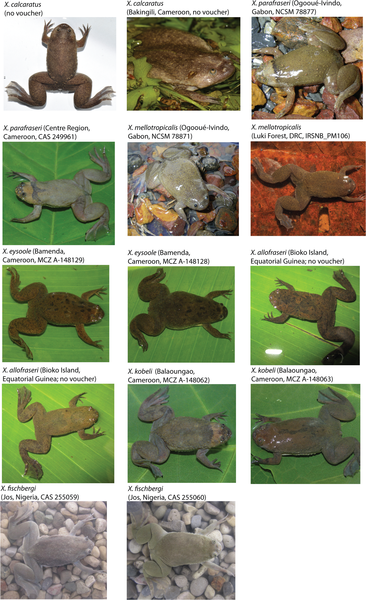New and "resurrected" species of clawed frogs.
Photos: From Evans et al 2015. Creative Commons Attribution 4.0.
Here's a new article in PLOS ONE, by Evans et al., with the descriptive title: Genetics, Morphology, Advertisement Calls, and Historical Records Distinguish Six New Polyploid Species of African Clawed Frog (
African clawed frogs, genus Xenopus, are extraordinary among vertebrates in the diversity of their polyploid species and the high number of independent polyploidization events that occurred during their diversification. Here we update current understanding of the evolutionary history of this group and describe six new species from west and central sub-Saharan Africa, including four tetraploids and two dodecaploids. We provide information on molecular variation, morphology, karyotypes, vocalizations, and estimated geographic ranges, which support the distinctiveness of these new species. We resurrect Xenopus calcaratus from synonymy of Xenopus tropicalis and refer populations from Bioko Island and coastal Cameroon (near Mt. Cameroon) to this species. To facilitate comparisons to the new species, we also provide comments on the type specimens, morphology, and distributions of X. epitropicalis, X. tropicalis, and X. fraseri. This includes significantly restricted application of the names X. fraseri and X. epitropicalis, the first of which we argue is known definitively only from type specimens and possibly one other specimen. Inferring the evolutionary histories of these new species allows refinement of species groups within Xenopus and leads to our recognition of two subgenera (Xenopus and Silurana) and three species groups within the subgenus Xenopus (amieti, laevis, and muelleri species groups). (Reproduced under Creative Commons Attribution 4.0).
